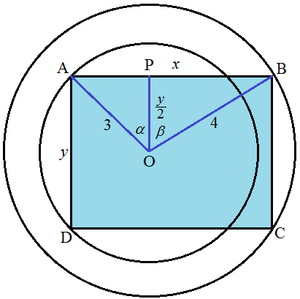One side for you, one side for me
Suppose we have two concentric circles of radii 3 and 4 , respectively. Let R be the largest rectangle with two adjacent vertices on the radius 3 circle and two adjacent vertices on the radius 4 circle.
Let x and y be the dimensions of R , with x > y . Then if x − y = b a , where a and b are positive coprime integers, find a + b .
The answer is 6.
This section requires Javascript.
You are seeing this because something didn't load right. We suggest you, (a) try
refreshing the page, (b) enabling javascript if it is disabled on your browser and,
finally, (c)
loading the
non-javascript version of this page
. We're sorry about the hassle.
3 solutions
Nice, concise solution! Thanks for posting it. :)

Let the center of the two circles be O and the rectangle be A B C D . The figure shows the arrangement for a larger rectangle. We note that the area of △ O A B is 4 1 of the area of the rectangle. Let O P = 2 y be perpendicular to A B , ∠ A O P = α , and ∠ B O P = β . Since area of △ O A B , [ O A B ] = 2 1 ( 3 ) ( 4 ) sin ( α + β ) , it only depends on sin ( α + β ) , likewise the area of rectangle, [ A B C D ] = x y is directly proportional to sin ( α + β ) . And the maximum sin ( α + β ) is 1, when α + β = 9 0 ∘ . When α + β = 9 0 ∘ , △ A O P is similar to △ B O P and ∠ O B P = ∠ A O P = α . Then we have:
cos ∠ A O P sin ∠ O B P ⟹ tan α y x ⟹ x − y = cos α = 6 y = sin α = 8 y = 4 3 = 6 cos α = 5 2 4 = 3 sin α + 4 cos α = 5 = 5 1 ⟹ sin α = 5 3 , cos α = 5 4
Therefore, a + b = 1 + 5 = 6 .
Realizing that the shape has to have a symmetry dividing the rectangle in half along a line passing through the center and parallel to one of the edges, the area is 2 y ( 3 2 − y 2 + 4 2 − y 2 ) . Taking the derivative of the area, setting the derivative to zero and solving for the inflection point, gives the sides of the rectangle: { 2 x , 3 2 − x 2 + 4 2 − x 2 } /. Solve [ ∂ x ∂ ( 2 x ( 3 2 − x 2 + 4 2 − x 2 ) ) = 0 ] ⟹ ( − 5 2 4 5 2 4 5 5 ) . Using the positive solution and realizing that 5 2 4 is less than 5 , With [ { result = 5 − 5 2 4 } , Denominator [ result ] + Numerator [ result ] ] ⟹ 6 .
Let R be rectangle A B C D such that A and D are vertices on the radius 4 circle, B and C are vertices on the radius 3 circle, O is the center of both circles, θ = ∠ C O D , x = A B = C D , and y = A D = B C .
The area of rectangle R is A R = x y . By symmetry, the height of △ O C D is h △ O C D = 2 1 y , so its area is A △ O C D = 4 1 x y . The area of △ O C D is also A △ O C D = 2 1 ⋅ 3 ⋅ 4 ⋅ sin θ . Solving all these equations gives A R = 2 4 sin θ .
Since sin θ has a maximum of 1 when θ = 9 0 ° , A R has a maximum of 2 4 when θ = 9 0 ° .
By Pythagorean's Theorem on △ O C D , x = 5 , and since A R = x y , y = 5 2 4 , which means x − y = 5 − 5 2 4 = 5 1 , so a = 1 and b = 5 , and a + b = 6 .